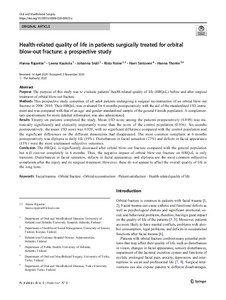Health-related quality of life in patients surgically treated for orbital blow-out fracture: a prospective study
Rajantie Hanna; Kaukola Leena; Snäll Johanna; Roine Risto; Sintonen Harri; Thorén Hanna
Health-related quality of life in patients surgically treated for orbital blow-out fracture: a prospective study
Rajantie Hanna
Kaukola Leena
Snäll Johanna
Roine Risto
Sintonen Harri
Thorén Hanna
SPRINGER HEIDELBERG
Julkaisun pysyvä osoite on:
https://urn.fi/URN:NBN:fi-fe2021042826210
https://urn.fi/URN:NBN:fi-fe2021042826210
Tiivistelmä
Purpose
The purpose of this study was to evaluate patients' health-related quality of life (HRQoL) before and after surgical treatment of orbital blow-out fracture.
Methods
This prospective study comprises of all adult patients undergoing a surgical reconstruction of an orbital blow-out fracture in 2006-2010. Their HRQoL was evaluated for 6 months postoperatively with the aid of the standardized 15D instrument and was compared with that of an age- and gender-standardized sample of the general Finnish population. A complementary questionnaire for more detailed information was also administered.
Results
Twenty-six patients completed the study. Mean 15D score among the patients preoperatively (0.898) was statistically significantly and clinically importantly worse than the score of the control population (0.936). Six months postoperatively, the mean 15D score was 0.920, with no significant difference compared with the control population and the significant differences on the different dimensions had disappeared. The most common complaint at 6 months postoperatively was diplopia in daily life (19%). Disturbances in facial sensation (27%) and defects in facial appearance (15%) were the most unpleasant subjective outcomes.
Conclusion
The HRQoL is significantly decreased after orbital blow-out fracture compared with the general population but will recover completely in 6 months. Thus, the negative impact of orbital blow-out fracture on HRQoL is only transient. Disturbances in facial sensation, defects in facial appearance, and diplopia are the most common subjective complaints after the injury and its surgical treatment. However, these do not appear to affect the overall quality of life in the long term.
Kokoelmat
- Rinnakkaistallenteet [27094]
